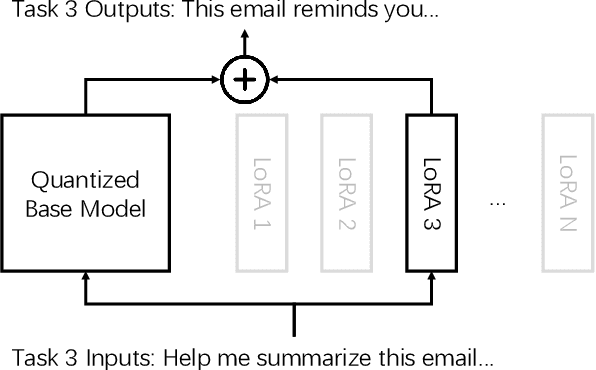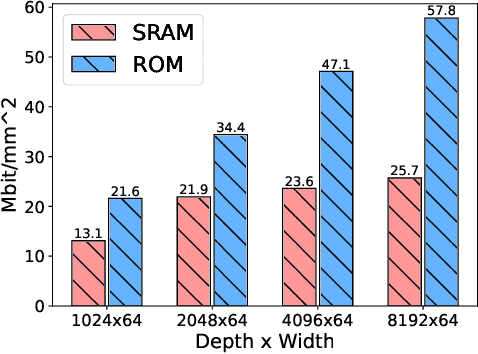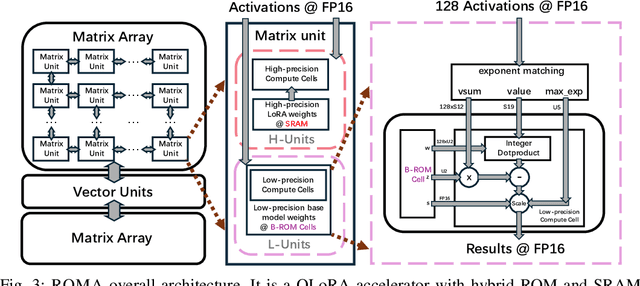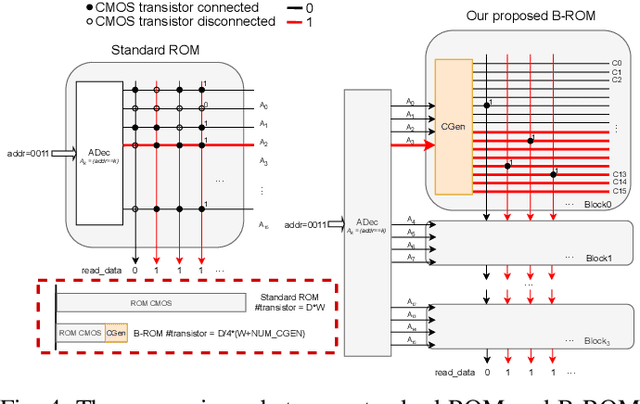Shijie Cao
Less Is More: Training-Free Sparse Attention with Global Locality for Efficient Reasoning
Aug 09, 2025Abstract:Large reasoning models achieve strong performance through test-time scaling but incur substantial computational overhead, particularly from excessive token generation when processing short input prompts. While sparse attention mechanisms can reduce latency and memory usage, existing approaches suffer from significant accuracy degradation due to accumulated errors during long-generation reasoning. These methods generally require either high token retention rates or expensive retraining. We introduce LessIsMore, a training-free sparse attention mechanism for reasoning tasks, which leverages global attention patterns rather than relying on traditional head-specific local optimizations. LessIsMore aggregates token selections from local attention heads with recent contextual information, enabling unified cross-head token ranking for future decoding layers. This unified selection improves generalization and efficiency by avoiding the need to maintain separate token subsets per head. Evaluation across diverse reasoning tasks and benchmarks shows that LessIsMore preserves -- and in some cases improves -- accuracy while achieving a $1.1\times$ average decoding speed-up compared to full attention. Moreover, LessIsMore attends to $2\times$ fewer tokens without accuracy loss, achieving a $1.13\times$ end-to-end speed-up compared to existing sparse attention methods.
Data Efficacy for Language Model Training
Jun 26, 2025Abstract:Data is fundamental to the training of language models (LM). Recent research has been dedicated to data efficiency, which aims to maximize performance by selecting a minimal or optimal subset of training data. Techniques such as data filtering, sampling, and selection play a crucial role in this area. To complement it, we define Data Efficacy, which focuses on maximizing performance by optimizing the organization of training data and remains relatively underexplored. This work introduces a general paradigm, DELT, for considering data efficacy in LM training, which highlights the significance of training data organization. DELT comprises three components: Data Scoring, Data Selection, and Data Ordering. Among these components, we design Learnability-Quality Scoring (LQS), as a new instance of Data Scoring, which considers both the learnability and quality of each data sample from the gradient consistency perspective. We also devise Folding Ordering (FO), as a novel instance of Data Ordering, which addresses issues such as model forgetting and data distribution bias. Comprehensive experiments validate the data efficacy in LM training, which demonstrates the following: Firstly, various instances of the proposed DELT enhance LM performance to varying degrees without increasing the data scale and model size. Secondly, among these instances, the combination of our proposed LQS for data scoring and Folding for data ordering achieves the most significant improvement. Lastly, data efficacy can be achieved together with data efficiency by applying data selection. Therefore, we believe that data efficacy is a promising foundational area in LM training.
SeerAttention-R: Sparse Attention Adaptation for Long Reasoning
Jun 10, 2025



Abstract:We introduce SeerAttention-R, a sparse attention framework specifically tailored for the long decoding of reasoning models. Extended from SeerAttention, SeerAttention-R retains the design of learning attention sparsity through a self-distilled gating mechanism, while removing query pooling to accommodate auto-regressive decoding. With a lightweight plug-in gating, SeerAttention-R is flexible and can be easily integrated into existing pretrained model without modifying the original parameters. We demonstrate that SeerAttention-R, trained on just 0.4B tokens, maintains near-lossless reasoning accuracy with 4K token budget in AIME benchmark under large sparse attention block sizes (64/128). Using TileLang, we develop a highly optimized sparse decoding kernel that achieves near-theoretical speedups of up to 9x over FlashAttention-3 on H100 GPU at 90% sparsity. Code is available at: https://github.com/microsoft/SeerAttention.
Rectified Sparse Attention
Jun 05, 2025Abstract:Efficient long-sequence generation is a critical challenge for Large Language Models. While recent sparse decoding methods improve efficiency, they suffer from KV cache misalignment, where approximation errors accumulate and degrade generation quality. In this work, we propose Rectified Sparse Attention (ReSA), a simple yet effective method that combines block-sparse attention with periodic dense rectification. By refreshing the KV cache at fixed intervals using a dense forward pass, ReSA bounds error accumulation and preserves alignment with the pretraining distribution. Experiments across math reasoning, language modeling, and retrieval tasks demonstrate that ReSA achieves near-lossless generation quality with significantly improved efficiency. Notably, ReSA delivers up to 2.42$\times$ end-to-end speedup under decoding at 256K sequence length, making it a practical solution for scalable long-context inference. Code is available at https://aka.ms/ReSA-LM.
BitDecoding: Unlocking Tensor Cores for Long-Context LLMs Decoding with Low-Bit KV Cache
Mar 24, 2025Abstract:The growing adoption of long-context Large Language Models (LLMs) has introduced significant memory and computational challenges in autoregressive decoding due to the expanding Key-Value (KV) cache. KV cache quantization has emerged as a promising solution, with prior work showing that 4-bit or even 2-bit quantization can maintain model accuracy while reducing memory costs. However, despite these benefits, preliminary implementations for the low-bit KV cache struggle to deliver the expected speedup due to quantization and dequantization overheads and the lack of Tensor Cores utilization. In this work, we propose BitDecoding, a GPU-optimized framework that unlocks Tensor Cores for efficient decoding with low-bit KV cache. Efficiently leveraging Tensor Cores for low-bit KV cache is challenging due to the dynamic nature of KV cache generation at each decoding step. BitDecoding addresses these challenges with a Tensor Cores-Centric BitFusion Scheme that ensures data layout compatibility to enable high utilization of Tensor Cores. Additionally, BitDecoding incorporates a warp-efficient parallel decoding kernel and a fine-grained asynchronous pipeline, minimizing dequantization overhead and improving computational efficiency. Experiments show that BitDecoding achieves up to 7.5x speedup on RTX 4090, 4.8x on A100, and 8.9x on H100, compared to FP16 FlashDecoding-v2. It also outperforms the state-of-the-art low-bit KV cache implementation (QServe) by up to 4.3x. On LLaMA-3.1-8B with a 128K sequence length, BitDecoding reduces single-batch decoding latency by 3x, demonstrating its effectiveness in long-context generation scenarios. The code is available at https://github.com/DD-DuDa/BitDecoding.
ROMA: a Read-Only-Memory-based Accelerator for QLoRA-based On-Device LLM
Mar 17, 2025



Abstract:As large language models (LLMs) demonstrate powerful capabilities, deploying them on edge devices has become increasingly crucial, offering advantages in privacy and real-time interaction. QLoRA has emerged as the standard approach for on-device LLMs, leveraging quantized models to reduce memory and computational costs while utilizing LoRA for task-specific adaptability. In this work, we propose ROMA, a QLoRA accelerator with a hybrid storage architecture that uses ROM for quantized base models and SRAM for LoRA weights and KV cache. Our insight is that the quantized base model is stable and converged, making it well-suited for ROM storage. Meanwhile, LoRA modules offer the flexibility to adapt to new data without requiring updates to the base model. To further reduce the area cost of ROM, we introduce a novel B-ROM design and integrate it with the compute unit to form a fused cell for efficient use of chip resources. ROMA can effectively store both a 4-bit 3B and a 2-bit 8B LLaMA model entirely on-chip, achieving a notable generation speed exceeding 20,000 tokens/s without requiring external memory.
Bitnet.cpp: Efficient Edge Inference for Ternary LLMs
Feb 17, 2025Abstract:The advent of 1-bit large language models (LLMs), led by BitNet b1.58, has spurred interest in ternary LLMs. Despite this, research and practical applications focusing on efficient edge inference for ternary LLMs remain scarce. To bridge this gap, we introduce Bitnet.cpp, an inference system optimized for BitNet b1.58 and ternary LLMs. Given that mixed-precision matrix multiplication (mpGEMM) constitutes the bulk of inference time in ternary LLMs, Bitnet.cpp incorporates a novel mpGEMM library to facilitate sub-2-bits-per-weight, efficient and lossless inference. The library features two core solutions: Ternary Lookup Table (TL), which addresses spatial inefficiencies of previous bit-wise methods, and Int2 with a Scale (I2_S), which ensures lossless edge inference, both enabling high-speed inference. Our experiments show that Bitnet.cpp achieves up to a 6.25x increase in speed over full-precision baselines and up to 2.32x over low-bit baselines, setting new benchmarks in the field. Additionally, we expand TL to element-wise lookup table (ELUT) for low-bit LLMs in the appendix, presenting both theoretical and empirical evidence of its considerable potential. Bitnet.cpp is publicly available at https://github.com/microsoft/BitNet/tree/paper , offering a sophisticated solution for the efficient and practical deployment of edge LLMs.
Automating Energy-Efficient GPU Kernel Generation: A Fast Search-Based Compilation Approach
Nov 28, 2024



Abstract:Deep Neural Networks (DNNs) have revolutionized various fields, but their deployment on GPUs often leads to significant energy consumption. Unlike existing methods for reducing GPU energy consumption, which are either hardware-inflexible or limited by workload constraints, this paper addresses the problem at the GPU kernel level. We propose a novel search-based compilation method to generate energy-efficient GPU kernels by incorporating energy efficiency into the search process. To accelerate the energy evaluation process, we develop an accurate energy cost model based on high-level kernel features. Furthermore, we introduce a dynamic updating strategy for the energy cost model, reducing the need for on-device energy measurements and accelerating the search process. Our evaluation demonstrates that the proposed approach can generate GPU kernels with up to 21.69% reduced energy consumption while maintaining low latency.
SeerAttention: Learning Intrinsic Sparse Attention in Your LLMs
Oct 17, 2024



Abstract:Attention is the cornerstone of modern Large Language Models (LLMs). Yet its quadratic complexity limits the efficiency and scalability of LLMs, especially for those with a long-context window. A promising approach addressing this limitation is to leverage the sparsity in attention. However, existing sparsity-based solutions predominantly rely on predefined patterns or heuristics to approximate sparsity. This practice falls short to fully capture the dynamic nature of attention sparsity in language-based tasks. This paper argues that attention sparsity should be learned rather than predefined. To this end, we design SeerAttention, a new Attention mechanism that augments the conventional attention with a learnable gate that adaptively selects significant blocks in an attention map and deems the rest blocks sparse. Such block-level sparsity effectively balances accuracy and speedup. To enable efficient learning of the gating network, we develop a customized FlashAttention implementation that extracts the block-level ground truth of attention map with minimum overhead. SeerAttention not only applies to post-training, but also excels in long-context fine-tuning. Our results show that at post-training stages, SeerAttention significantly outperforms state-of-the-art static or heuristic-based sparse attention methods, while also being more versatile and flexible to adapt to varying context lengths and sparsity ratios. When applied to long-context fine-tuning with YaRN, SeerAttention can achieve a remarkable 90% sparsity ratio at a 32k context length with minimal perplexity loss, offering a 5.67x speedup over FlashAttention-2.
LUT Tensor Core: Lookup Table Enables Efficient Low-Bit LLM Inference Acceleration
Aug 12, 2024Abstract:As large language model (LLM) inference demands ever-greater resources, there is a rapid growing trend of using low-bit weights to shrink memory usage and boost inference efficiency. However, these low-bit LLMs introduce the need for mixed-precision matrix multiplication (mpGEMM), which is a crucial yet under-explored operation that involves multiplying lower-precision weights with higher-precision activations. Unfortunately, current hardware does not natively support mpGEMM, resulting in indirect and inefficient dequantization-based implementations. To address the mpGEMM requirements in low-bit LLMs, we explored the lookup table (LUT)-based approach for mpGEMM. However, a conventional LUT implementation falls short of its potential. To fully harness the power of LUT-based mpGEMM, we introduce LUT Tensor Core, a software-hardware co-design optimized for low-bit LLM inference. Specifically, we introduce software-based operator fusion and table symmetrization techniques to optimize table precompute and table storage, respectively. Then, LUT Tensor Core proposes the hardware design featuring an elongated tiling shape design to enhance table reuse and a bit-serial design to support various precision combinations in mpGEMM. Moreover, we design an end-to-end compilation stack with new instructions for LUT-based mpGEMM, enabling efficient LLM compilation and optimizations. The evaluation on low-bit LLMs (e.g., BitNet, LLAMA) shows that LUT Tensor Core achieves more than a magnitude of improvements on both compute density and energy efficiency.
 Add to Chrome
Add to Chrome Add to Firefox
Add to Firefox Add to Edge
Add to Edge